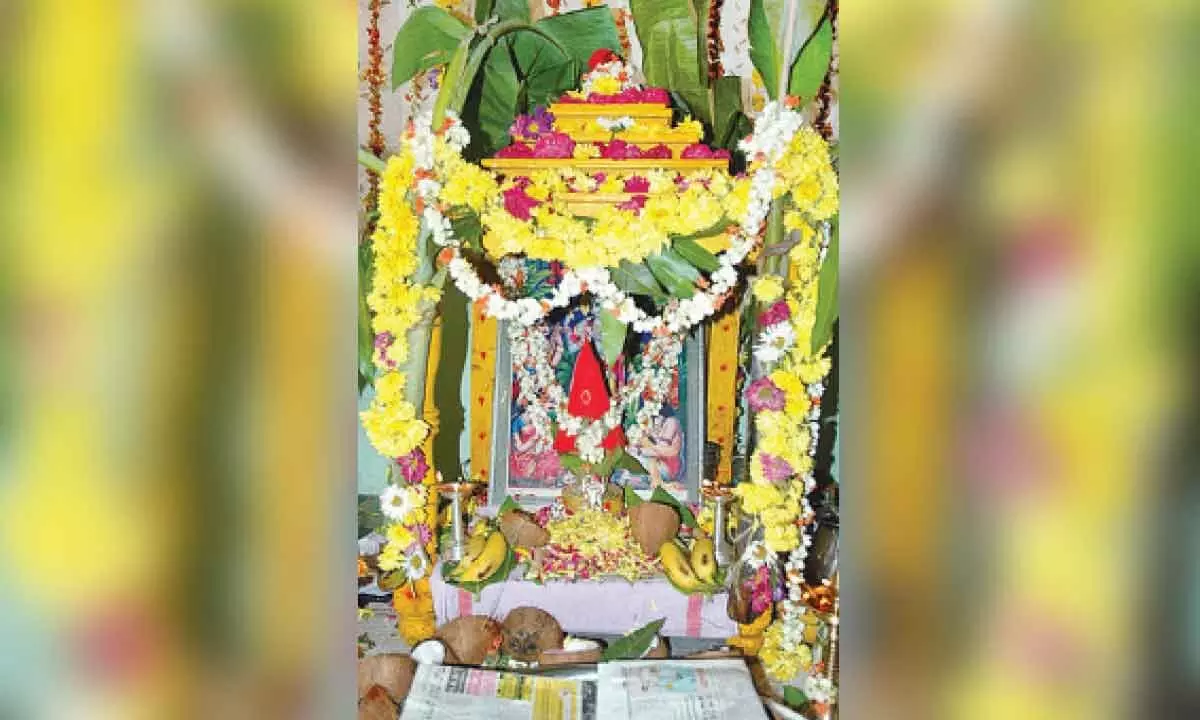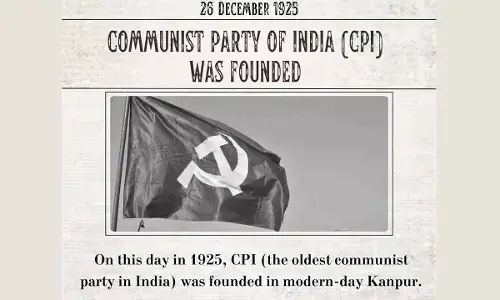Satyanarayana Vrata stories exemplify socialism ideals

Satyanarayana Vratam can be performed by anyone, irrespective of caste, creed and colour whether they are rich or poor, forward, or backward class. In the entire world, if there is any socialistic story, then, it is only the story of Satyanarayana Vratam, claims Padmashree Garikapati Narasimha Rao. The essence of these stories is whoever performs Satyanarayana worship and listens to stories will obtain riches and wealth and will live happily before attaining salvation after death
Praying to Lord Vishnu, whose incarnation is believed to be Satyanarayana Swamy, and performing ‘Satyanarayana Vratam and Pooja’ and then, interestingly listening to the five-chapter story (Katha), for the health, wealth, prosperity, and wellbeing in all aspects, is an established, acknowledged, and sanctified tradition in every Hindu family in almost all parts of India. In addition to native Indians, Non-Resident Indians in many countries also perform this, evincing the same keen and equal interest. The priest (Pujari) while narrating the five stories, in succession, quotes chapters from famous ‘Skanda Purana’ and ‘Reva Khanda.’
The importance of pooja and its process is believed to be delivered by ‘Great Sage Suta’ to ‘Shounaka Sages’ in Naimisha forest. Skanda Purana with Reva Khanda is one of the 18 (Astha Dasha) world famous Hindu Puranas authored by Maharshi ‘Veda Vyasa.’ These are: Markandeya, Matsya, Bhagavata, Bhavishya, Brahmanda, Brahma Purana, Brahma Vivarta, Vishnu, Varaha, Vamana, Vaayu, Agni, Narada, Padma, Linga, Garuda, Kurma, and Skanda Purana. All puranas describe Indian culture, tradition, and philosophies. Vedic and puranic genealogies indicate a greater antiquity of Vedic culture. Among all Puranas, Skanda Purana is huge one and the biggest in size, consisting of 81,000 verses narrated by Skandha. It describes the story of Shiva and birth of Skandha.
The ‘International Journal of Sanskrit Research’ records very interesting observations. Puranas form important branch of sacred literature of India. They speak the true purpose of ethics, philosophy, and religion of Vedas. They are the frameworks of (The Science of Virtue) Dharma shastra, and were written, according to Indian tradition. The Puranas also describe the historic evolution of the mankind and describe the ‘Eternal Cycle of Creation, Destruction and Recreation of world.’ Puranas also reflect in detail the contemporary life and thought of the society. The trinity of gods Brahma, Vishnu and Maheshwara are one single divinity associated with the three cosmic functions of creation, preservation and destruction of the universe respectively.
Satyanarayana Vratam which is believed to be found in Reva Khanda is unacceptable to a few historians, according to whom, Skanda Purana as we have it now has a lot of insertions in the original text that do not match typical Puranic subjects. Their apprehension is that Satyanarayana Vrata has no relationship to Reva Khanda or Skanda Purana. The fact, however, is that, nowhere the story is heard, without reference to Skanda Purana and Reva Khanda. The broad text as it appears in Skanda Purana is, however, quite interesting and it generates added interest depending on the talent and skill of priest (Pujari), which these days is bit scarce.
A decade ago, at a community level Satyanarayana Vratam performed by 1,108 couple simultaneously, in the erstwhile Medak district’s Matkoot Village, organized by Spiritualist Darshanam Sharma, the way Padmashree Awardee Garikipati Narasimha Rao narrated the story was incredible and the large audience was thrilled to listen to him. According to him, the Satyanarayana Vratam can be performed by anyone irrespective of caste, creed and colour whether they are rich or poor, forward, or backward class. He asserted that, “in the entire world if there is any socialistic story, then, it is only the story of Satyanarayana Vratam.”
In Chapter One, the genesis of Satyanarayana Vrata was retold by ‘Great Sage Suta’ in Naimisha Forest to ‘Shounaka Sages,’ quoting Sage Narada as briefed by Lord Vishnu, answering his query as to what is the best worship for fulfilling desires. Vishnu to Narada and Suta to Shounaka Sages narrated the necessity, procedure, importance, and results of performing Satyanarayana Puja and, if done systematically adhering to religious rites, people will be happy in this life and attain salvation after death.
In chapter two, the story of a very poor Brahmin living in the city of Kashi was told by ‘Sage Suta’ to ‘Shounaka Sages.’ Lord Vishnu as an Old Brahmin appeared to him and advised to perform Satyanarayana Puja to overcome his poverty and disappeared. Next day, when the Kashi Brahmin decided to perform the worship, he collected adequate money through traditional begging. After performing Puja, all his suffering vanished, and he finally attained moksha (salvation) on his death.
Once, when the Brahmin was performing Puja, a woodcutter came to his house, sat all through, had the holy Prasadam (an eatable offered to God) and on knowing details, he decided to perform the same following day. He had profitable sales of his wood with adequate money and on completion of his worship, he gained wealth, children, happiness, and prosperity for all of his remaining life and attained salvation on death.
Chapters three and four deal with the story of a wise king named Ulkhamukha. One day, when the royal couple was performing Satyanarayana Puja on the banks of a river, a merchant by the name of Sadhu saw the king and on knowing that they were performing it to be blessed with children, Sadhu, too, decided to perform for children and accordingly informed his wife Lilavati and took a pledge that they would do after getting a child. In spite of being blessed with a girl child (Kalavati), he went on postponing to perform, including after her marriage.
While he was on a business trip with his son-in-law, to the seaside town of Ratnapura, he had to face the wrath of King Chandraketu, due to the illusion created by Lord Satyanarayana, and were imprisoned besides having their merchandise confiscated. The housewives Lilavati and Kalavati were also afflicted with sorrows. At the end, all was well when Lilavati performed Satyanarayana Puja and Sadhu and his son-in-law were released from jail and returned home with gifts from king and huge profits, but not before yet another assessment of their commitment. When Kalavati forgot an important part of the puja to take Prasadam (holy dish), the merchants faced problems. Later, Sadhu performed Satyanarayana worship on every full moon and Sankranti without fail for the rest of his life. He lived comfortably and attained salvation after his death.
In chapter five, the story was that a king by name Thungadhvaja was once hunting in a forest and on seeing some cowherds performing Satyanarayana Puja under a Bilva tree, he refused to accept the holy dish (Prasadam) offered by them. Angered, Lord Satyanarayana caused death of king's 100 sons, destroyed his wealth and belongings, made him extremely poor and afflicted with various hardships. King realising his error, went to the cowherds and performed Satyanarayana Puja with them and immediately regained his kingdom, riches, and sons. Later, he lived happily as long as he was alive and attained salvation. The essence of these stories is whoever performs Satyanarayana worship and listens to stories will obtain riches and wealth and will live happily before attaining salvation after death.
Motilal Banarsidass, having established a book shop in 1903 at Lahore (Pakistan), after an unforeseen experience as a result of partition of India in 1947, built everything from ground up in India post partition. Focusing on publication of books of lasting value that delve deep in cultural heritage of India and Indian philosophy, which was being greatly appreciated by the west, among others, published the Skanda Purana in 23 parts in English. These volumes contain legends of Siva, especially his battles with Daityas and Danavs. There are sections of Yoga, Dhyana (Meditation), and Jnana (Knowledge). It describes Shiva temples in and around Varanasi. It is encyclopedic in character and throws light on different topics of general interest.
(The writer is Chief Public Relations Officer to Chief Minister Telangana)

















